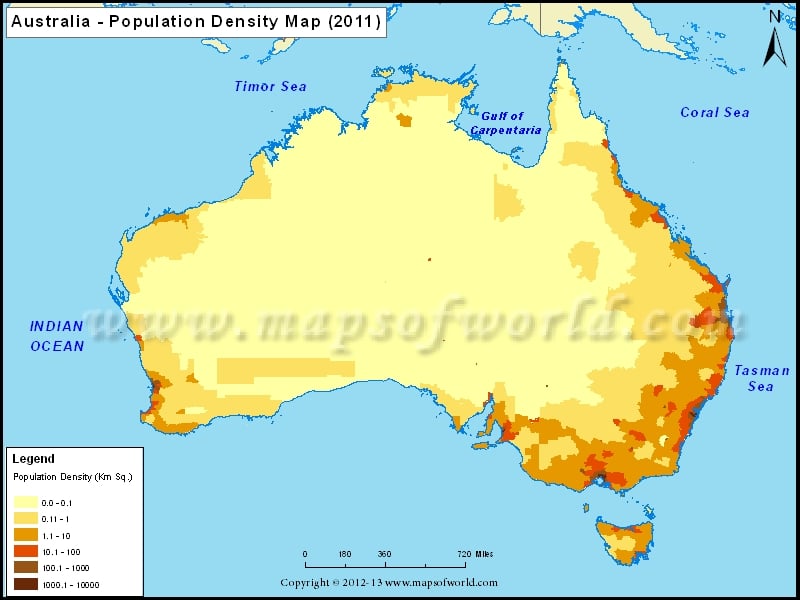Year Wise Population Graph of Australia
Demography
Population
The total official population of Australia for the year 2016, is 24.13 million.
For 2014, the estimated birthrate is 12.19 births per 1,000, and the death rate is 7.07 deaths per 1,000 of population, while the infant mortality rate is 4.43 deaths per 1,000 live births. The sex ratio is estimated to be 1.06 males per female, and the growth rate of the population is estimated at 1.09%.
The distribution of population in Australia is heavily slanted. The two coastal areas of the southeast and southwest, situated on opposite sides of the continent, are home to the majority of the population. The population densities are highest along these seaboards, particularly in the cities. However, the population density reduces drastically once you travel inland towards the center of the country. The central Australian estimated population density is 2 persons per square miles.
The 2016 figures for age structure in Australia show that 17.84% of the population consists of children between 0-14 years, 12.96% of the population is in the early working age between 15-24 years, 41.55% of the population is in the prime working age between 25-54 years, 11.82% of the population is in the mature working age between 55-64 years, and 15.82% of the population is elderly, age 65 years and over.
As per a 2015 estimate, 89.4% of the total population in Australia is classified as urban population, while the remaining 10.6% is classified as rural population.
Social Attributes
The main religion in Australia is Christianity, comprising of Protestants, Catholics, Eastern Orthodox, and other Christian faiths, the country also has Buddhists, Muslims, and followers of other unspecified religions.
The languages spoken in Australia are English, Chinese, Italian, Greek, Arabic, Vietnamese, and other unspecified languages. The country has no official national language, but English is considered to be the de facto national language since it is used by majority of the people.
Ethnic groups living in Australia include whites, Asians, and aboriginals.
Famous Australians
Several Australians have made their mark in the world, some notables:
- Academy Award Winning Actors: Geoffrey Rush, Russel Crowe, Nicole Kidman, and Cate Blanchett
- Film Personalities: Hugh Jackman, Naomi Watts, Heath Ledger, Guy Pearce, Eric Bana, Toni Collette, Rachel Griffiths and Paul Hogan
- Music: Kylie Minogue, Olivia Newton John, AC/DC
- Film Directors: Bruce Beresford, Baz Lurhmann, Jocelyn Moorhouse, Phillip Noyce, Fred Schepsi and Peter Weir
- Cricketing Legends: Sir Donald Bradman, Ritchie Benaud, Allan Border, the Waugh brothers, Shane Warne and Glen McGrath
- Swimmers: Dawn Fraser, Shane Gould, Kieren Perkins, and Ian Thorpe
- Runner: Cathy Freeman
- Tennis Stars: Rod Laver, Ken Rosewall, John Newcombe, Pat Cash, Pat Rafter, Lleyton Hewitt, Margaret Court, and Evonne Goolagong Cawley
- Nobel Prize winning Pharmacologist and Pathologist: Howard Florey
- Nobel Prize Winning Scientists: William Bragg, John Warcup Cornforth, John Eccles, Bernard Katz, Peter Doherty, and Elizabeth Blackburn
- Cardiac Surgeon: Victor Chang
- Ophthalmologist: Fred Hollows and media mogul Rupert Murdoch.
Environmental Geography
Biodiversity
Australia is believed to be home to over a million different species of plants and animals, and many are not found anywhere else in the world.
Iconic flora of Australia includes; the hummock grasslands, as well as trees belonging to the genera of Acacia, Eucalyptus, Melaleuca, Grevillea, and Allocasuarina. While iconic fauna are the Kangaroo, Koala, Echidna, Dingo, Platypus, Wallaby, and Wombat.
National Parks
Australia has more than 500 National Parks, spread over the 28 million hectares of land. Six National Parks are managed by the Australian Government, while the rest are looked after by the respective states and territories. These six Commonwealth National Parks are: Booderee National Park, New South Wales; Christmas Island National Park, Christmas Island; Kakadu National Park, Northern Territory; Norfolk Island National Park, Norfolk Island; Pulu Keeling National Park, Cocos (Keeling) Islands; and Uluru-Kata Tjuta National Park, Northern Territory.
